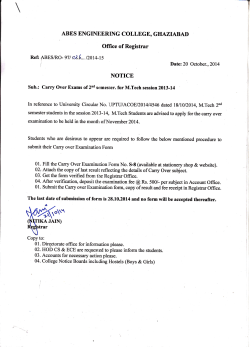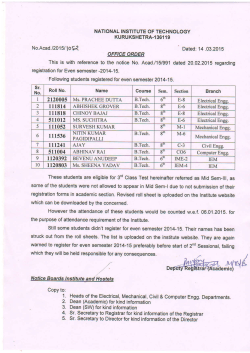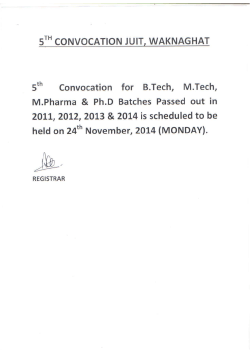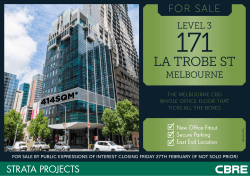
Tech Trek: A Walk Through Some of Philadelphia`s Top Tech Clusters
VIEWPOINT Greater Philadelphia Tech Tech Trek: A Walk Through Some of Philadelphia’s Top Tech Clusters Ian Anderson Director of Research and Analysis Lauren Koshgarian Senior Research Analyst • This report highlights nine of the major tech clusters around the Greater Philadelphia area1. • Our study focuses on the 313 technology companies that populate this landscape. • In our research, we’ve found that the majority of tech companies in these market clusters are early-funding and startup firms (44.4%). • The majority of tech tenants in this zone are SaaS (software-as-aservice) companies (41.8%). • The majority of tech tenants in these clusters are located in Class A (56.8%) Office space. 1 The geographic clusters selected were chosen either becasue they represent the most established tech clusters in the region, or because they are emerging tech clusters that offer a point of comparison to their more established counterparts. APRIL 2015 CBRE Research ©2015, CBRE, Inc. | 1 V I E W P O I N T GREATER PHILADELPHIA TECH T E C H C L U S T E R S B R E A K D O W N: • 6 markets are urban and 3 markets are suburban • 4 out of 9 markets are mainly office parks • 4 out of 9 markets are anchored by Oracle, Comcast, and IBM • 8 out of 9 markets have transit • 7 out of 9 markets are located near a major highway exit • 2 out of 9 markets are within 10 miles of the Philadelphia International Airport 313 COMPANIES REPORTED BUILDING CLASS BUILDING TYPE Class A: 56.9% Class B: 33.9% Class C: 9.3% Office: 91.1% Retail: 1.9% Other: 7.0% FINANCIAL MATURITY ( , EMERGING, ESTABLISHED) 44.4% 31.3% 24.3% TENANT MIX ( , IT SERVICES, SOFTWARE) 22.7% 35.5% 41.8% CURRENT TECHNOLOGY TENANTS IN THE MARKET: • 55% of them are looking for space under 25,000 sq. ft. • 30% are looking for space between 26,000 and 60,000 sq. ft. • 15% are looking for space from 61,000 sq. ft. and up * We define startup as young, smaller firms with little to no investment funding and revenues below $10 million. We define emerging companies as firms with revenues between $10 million and $100 million. Finally, we define established tech companies as firms with revenues exceeding $100 million or those that are publicly traded. Source: CBRE Research, Q1 2015. APRIL 2015 CBRE Research ©2015, CBRE, Inc. | 2 V I E W P O I N T GREATER PHILADELPHIA TECH TECH CLUSTERS SUBMARKET “TECH ALLEY”/ ROUTE 202 CORRIDOR “INNOVATION OUTPOST”/ PLYMOUTH MEETING AND BLUE BELL BUILDING CLASS BUILDING TYPE Class A: 60.6% Class B: 32.6% Class C: 6.8% Office: 91.6% Retail: 0.8% Other: 7.8% Office: 90.5% Other: 9.5% Class A: 77.6% Class B: 18.4% Class C: 4.0% Office: 93.9% Retail: 2.0% Other: 4.1% UNIVERSITY CITY Class A: 21.4% Class B: 71.4% Class C: 7.2% Office: 92.9% Other: 7.1% CENTER CITY Class A: 70.2% Class B: 23.4% Class C: 6.4% Office: 89.36% Retail: 4.26% Other: 6.38% NAVY YARD Class A: 33.3% Class B: 58.4% Class C: 8.3% Office: 91.7% Other: 8.3% Class B: 33.3% Class C: 66.7% Office: 83.3% Retail: 16.7% MIDTOWN VILLAGE ( , EMERGING, ESTABLISHED) 37.1% 35.6% 27.3% Class A: 47.6% Class B: 45.2% Class C: 7.2% “TRANSIT TECH”/RADNOR AND CONSHOHOCKEN FINANCIAL MATURITY TENANT MIX ( , IT SERVICES, SOFTWARE) COMMUTE TYPE (CAR, PUBLIC, PEDESTRIAN-FRIENDLY) 28.8% 39.4% 31.8% 11.9% 31.0% 33.3% 35.7% 34.7% 46.9% 18.4% 14.3% 38.1% 47.6% 22.5% 38.8% 38.8% 7.1% 28.6% 64.3% 85.7% 29.8% 25.6% 44.7% 19.1% 36.2% 44.7% 8.3% 25.0% 16.7% 58.3% 16.7% 25.0% 33.3% 83.3% 66.7% 50.0% 16.7% “NOLIBS” NORTHERN LIBERTIES N3RD STREET Class B: 25.0% Class C: 75.0% Office: 75.0% Retail: 25.0% Class B: 57.1% Class C: 42.9% Office: 85.7% Retail: 14.3% 100.0% 14.3% 25.0% 75.0% 14.3% 28.6% 85.7% 57.1% Sources: CBRE Research, Q1 2015. T E C H C O M PA N I E S B R E A K D O W N: With a highly educated, young workforce, growth in venture capital investments, and the high number of tech startups, Philadelphia is poised for an expansion of its technology and tech-enabled services sector. As startups and established tech firms alike continue building their brands and attracting new clients, the local area remains a prime location for top-notch talent, networking, and an abundance of great real estate. APRIL 2015 CBRE Research ©2015, CBRE, Inc. | 3 V I E W P O I N T GREATER PHILADELPHIA TECH Philadelphia’s startup scene is showcasing itself as a major part of the real estate market and becoming vital to the continued success of the local economy. The area has a pulsing energy in the startup realm and our research indicates that it’s not just confined to city zones. We’re seeing startups and early funding companies residing in the suburbs as well. In our research, we’ve tracked the progression of local companies moving from startup to investment growth to successful exit and we expect to see more M&A and funding activity in the coming year. With each stage of advancement for a company, real estate decisions are directly tied into corporate growth plans. Suburban companies continue to open satellite offices in the city to lure urban talent, but these established firms still keep a steady presence and a large footprint in the suburbs. While emerging firms are spread fairly evenly throughout the region, startups and early funding companies continue to represent the majority of tech firms in the city. The growth of the local tech sector is positively impacting Philadelphia’s commercial real estate market. Older suburban buildings are being eyed for renovation while industrial, retail, and mixed-use space in the city experience redevelopment and a surge in tech tenants of all stages and sizes. Philadelphia’s successful co-working space also continues to expand and we expect this trend to remain steady and begin trickling out into the suburbs as well. With established tech firms expanding their presence in the city, startups joining the large coworking community, and emerging firms moving from mixed-use retail spaces to creative and office space, Philadelphia is emerging as a tech hub. In our research, we concentrate on three primary tech sectors: IT Services, Software, and Software-as-aService. Philadelphia is a highly connected, very networked city and companies that establish themselves in these three categories can find a number of local clients that otherwise might be difficult to track down in a larger city. WHY THE CITY FOR TECH: In contrast to a decade ago, the city is now emerging as an epicenter for tech entrepreneurs, venture capitalists, and a highly educated, millennial workforce that is expected to grow the local community for years to come. Many technology tenants in urban areas are startups and lack adequate credit. Landlords usually want to see already profitable tenants who can show positive cash flow and/or liquidity prior to leasing them space. Because of this, startups must choose spaces that make sense for them and their financial situation. Among Detroit, APRIL 2015 CBRE Research ©2015, CBRE, Inc. | 4 V I E W P O I N T GREATER PHILADELPHIA TECH Baltimore, DC, NYC, and Boston, Philadelphia has the highest growth rate of proprietors without employees (63.5%)2. This helps grow a major startup-friendly community in the local area. The tech sector is also quite possibly the most competitive market in terms of attracting and retaining talent, so companies use their buildings and their locations to reflect wider incentives for why personnel should join their company. Tech companies tend to put down roots in areas that will please their talent, including a trendy, up-and-coming area, after-5 / live-work-play neighborhood, and the unique industrial- style attributes of buildings. Tech companies were possibly the first tenants to prefer open layouts, collaborate spaces, loft-like ceilings, and exposed brick walls and wood beams. What previously would have been described as mixed-use industrial space in the late 1990s now holds all of the attributes of a Class A creative workspace for top talent. The atmosphere and layout are already here in much of Philadelphia’s neighborhoods. In our research, we’ve focused mainly on University City, Center City, Navy Yard, Midtown Village, Northern Liberties, and N3rd Street. U N I V E R S I T Y C I T Y: As the academic heart of Philadelphia, University City is known for its young, tech-savvy workforce and its growing startup community. The majority of tech tenants here are SaaS (64.3%) and startups (85.7%), and can be found in Class B office space (71.4%). A portion near 30th Street Station is a Keystone Innovation Zone and its close proximity to the University of Pennsylvania and Drexel University makes it an attractive area for startups looking for young tech talent. The amenity base in this area ranges from its popular street-food scene to higher-end dining establishments, art galleries, and a lively nightlife. C E N T E R C I T Y: Centrally located in the heart of downtown Philadelphia, Center City is growing up to be one of the hottest tech hubs in the U.S. With the new Comcast tower built to house only tech tenants and with an increasing coworking space community, it is one of the best areas for large and small companies alike. Comcast’s long-term investment in Philadelphia and its new Innovation Tower are encouraging tech companies to gather in this area and further grow the startup scene. These startup firms will be a viable force in the urban areas in the near-term and ultimately a presence in the suburban market in the long-term. We expect this sector to drive up demand and asking rents in the area’s Class A properties. We expect that with Comcast’s expanding footprint 2 Technical.ly Philly, “Philly’s city wage tax just turned 75. Here’s its dubious legacy.” December 12, 2014. APRIL 2015 CBRE Research ©2015, CBRE, Inc. | 5 V I E W P O I N T GREATER PHILADELPHIA TECH and with their new innovation tower, other tech firms small and large alike will likely either expand their footprint or move their location nearer to this market. The most popular space for tech tenants here tends to be Class A office, but we have seen a few reside in older spaces above retail as well. Companies here are closely split between SaaS (44.7%) and IT services (36.2%) and the majority are in the startup and earlier funding stages (44.7%). N AV Y YA R D : Known as one of the hottest corporate centers in Philadelphia, the Navy Yard is a modern business campus filled with customizable, sustainable, and one-of-akind spaces. Unlike other areas we’ve looked at, the Navy Yard offers companies flexibility for growth and generous expansion to remain in the community. The area is a Keystone Innovation Zone and it can accommodate expansion and growth with the capacity to develop another 4 million sq. ft. of office space. The properties are a mixed use of space including Office, Industrial, Manufacturing, and Research and Development. The Navy Yard’s growing list of amenities includes parks and recreation and a hotel on-campus, making it an increasingly attractive area for notable companies like Revzilla, Benjamin Franklin Technology Partners, and American Systems. The Navy Yard’s location is almost suburban due to its distance to Center City but the Philadelphia Airport is fairly close and I-95 access is excellent. The majority of tech tenants here tend to be SaaS (66.7%) and the majority are in the startup and early funding stages (58.3%). M I D TO W N V I L L AG E : As one of the top up-and-coming locations for tech startups, Midtown Village is known for being a 9-to-5 and After-5 neighborhood. Its boutique shops and growing list of restaurants make it an appealing location for smaller companies wanting to set up shop above these retail establishments. Many of the spaces above these areas have been converted into lofts and creative office space. Developers tell us that there is also a growing trend for established, suburban companies opening up “satellite” offices here hoping to lure young tech workers into joining their company. The majority of tech tenants here are startups (83.3%) and SaaS (50%). N O R T H E R N L I B E R T I E S : “NoLibs” is an up and comer for tech tenants, but an established neighborhood for residents and entrepreneurs alike. It began as a manufacturing district and has transformed into a progressive, walkable neighborhood filled with boutique shops, art galleries, dining, and nightlife. Today, it is one of the fastest growing neighborhoods in Philadelphia. There is a lot of environmentallyfriendly construction here and mixed-use complexes with industrial bones. Many of the tech tenants here are in IT services (75%) and the vast majority are early funding and APRIL 2015 CBRE Research ©2015, CBRE, Inc. | 6 V I E W P O I N T GREATER PHILADELPHIA TECH startups. N 3 R D S T R E E T: In-between Fishtown, Northern Liberties, and Old City, N3rd Street is the city’s hottest burgeoning tech hub. The properties are more unique and tenants are almost equally dispersed amidst Class B (57.1%) and Class C (42.9%) properties. Many of these properties were not traditional office space. Tech startups in this neighborhood can often be found hiding above residential and retail space or in one of the popular coworking spaces (Indy Hall or Devnuts). Redevelopment is growing in popularity and a great example is the Destination Maternity building being redone for creative companies. This up-and-coming area is known for its hip, young workforce with many budding entrepreneurs and startups, most notably including i-Site and Jarvus. WHY THE SUBURBS FOR TECH: Despite Philadelphia’s growing urban popularity amidst residents, students, and companies alike, a large number of established tech firms continue to have a stronghold in the suburbs. These suburban submarkets meet their needs for expanding floorplans, low taxes, local university talent in the suburbs, and the proximity to high-end neighborhoods where key decision-makers reside. However, given the prime tech talent in urban areas, larger companies are also seen opting for less traditional, smaller office space in hopes of luring talent into their doors. Due to the continued high demand for Class A office space in the suburbs, buildings that have the potential to be converted into Class A will most likely be updated. To position a building as Class A in this area, it would need a large amount of revamping done, including upgrading the lobby, creating collaborative common areas, and revitalizing the building tech systems. In our research, we’ve focused mainly on the Route 202 corridor, Plymouth Meeting and Blue Bell, and Radnor and Conshohocken. R O U T E 2 0 2 C O R R I D O R “ T E C H A L L E Y ” : Stretching from Exton to King of Prussia, Philadelphia’s “Tech Alley” is by far the largest submarket. It remains an affluent area with a great roadway system and it has a very strong amenity base, including the King of Prussia Mall. Many of the office buildings within its corporate centers are mulling redevelopment to meet additional demand. A number of older buildings have been renovated to appeal to Class A tenants. Historically, the Tech Alley has been a hub for well-established tech companies and public corporations, including notable companies Kenexa, LiquidHub, Oracle, Accenture, and Siemens. Surprisingly, the number of startups (35.6%) and established (37.1%) firms are closely split and together encompass roughly 73% of the market. The majority of tech tenants are located in Class A office APRIL 2015 CBRE Research ©2015, CBRE, Inc. | 7 V I E W P O I N T GREATER PHILADELPHIA TECH properties (60.6%) and the tenant mix is fairly evenly mixed between SaaS (39.4%), IT services (31.8%), and software companies (28.8%). P LY M O U T H M E E T I N G A N D B L U E B E L L “ I N N OVAT I O N O U T P O S T ” : Plymouth Meeting and Blue Bell are centrally located and known for their major business parks, good neighborhoods, and expansive highway system. Its strong amenity base of large and small-scale retail, dining, and entertainment make it a popular area for corporations to call home. Notable companies include Pet360, Unisys, UniTek, and Xerox. Here, IT services (47.6%) are the most popular tenants with SaaS following closely behind (38.1%) and the properties are a mix between Class A (47.6%) and Class B (45.2%) office. In terms of maturity, there is a surprisingly even mix between startup (33.3%) and established (31.0%), but emerging companies edge them out slightly at 35.7%. R A D N O R A N D C O N S H O H O C K E N “ T R A N S I T T E C H ” : Conshohocken and Radnor are known for their trophy Class A properties and their excellent transportation system with access via I-476 and the regional rail system. Both areas have a strong amenity base with lots of walkability, creating a more “urban-like” environment tucked within the suburbs. High-end suburban areas house the executive decision-makers which adds to the area’s appeal. There is continued strong demand in the market and inventory is tight. Land costs and barriers to new development are high, which increases rents. Conshohocken and Radnor remain appealing to employers, as a young and educated workforce surrounds them with nearby suburban universities like Villanova, Haverford, and Bryn Mawr. Tenants in this market include a high number of public or established companies (34.7%), including Qlik Technologies, Capgemini, Gartner, and eMoney, but startups and early funding companies (46.9%) still manage to outrank them. We think this could be due in part to the M&A activity here, including Compoze Software (acquired by Oracle), Empathy Lab (acquired by EPAM Systems), Phase Forward (acquired by Oracle), and Quintiq (acquired by Dassault Systems). The majority of tenants reside in Class A (77.6%) office properties. Data for the above report was drawn from CrunchBase, Inc5000, CoStar, and CBRE Research. For more insight into the Philadelphia tech market, see our February research report, “Changing employment patterns in Philly’s tech industry.” APRIL 2015 CBRE Research ©2015, CBRE, Inc. | 8 V I E W P O I N T GREATER PHILADELPHIA TECH AMERICAS RESEARCH Ian Anderson Director of Research and Analysis +1 215 561 8997 ian.anderson2@cbre.com Lauren Koshgarian Senior Research Analyst +1 215 561 8932 lauren.koshgarian@cbre.com To learn more about CBRE Research or to download our reports, visit cbre.com/research Disclaimer: Information contained herein, including projections, has been obtained from sources believed to be reliable. While we do not doubt its accuracy, we have not verified it and make no guarantee, warranty or representation about it. It is your responsibility to confirm independently its accuracy and completeness. This information is presented exclusively for use by CBRE clients and professionals and all rights to the material are reserved and cannot be reproduced without prior written permission of CBRE.
© Copyright 2025









